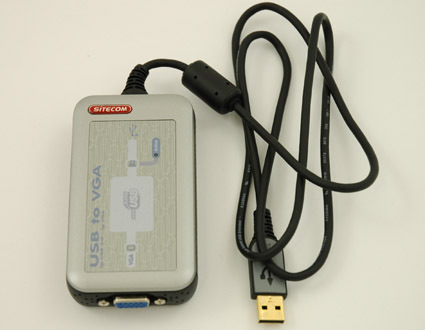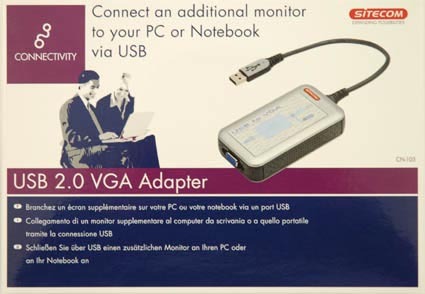Add A Monitor Using USB: Sitecom's VGA Adapter
Installation: Plug & Play?
The box's VGA-Port and the USB-2.0 connection cable.
Costing about $110, the adapter comes in a classic slipcase-type box that also includes the driver CD and the manual (72 pages DIN A6 format, in 9 languages). Fortunately, despite what the picture on the box shows, the USB cable is about 3 feet long; this leaves enough leeway to stow both adapter and monitor cable out of sight. The adapter itself is about the size of a cell phone and is encased in a plastic shell that seems quite sturdy.
The adapter is compatible with any computer that runs Windows 2000 or Windows XP and has a free USB 2.0 port; currently, there are no drivers for Linux or Mac OS. Systems using USB 1.1 don't qualify either, since the older standard doesn't offer enough bandwidth for sufficiently high screen refresh rates.
Usually, a quick look at the device manager is all it takes to determine what type of USB ports your system uses. However, sometimes the device driver or device name don't tell you much about its capabilities. In these cases, we recommend using the msinfo32 system tool that comes with Windows and can be found under C:\Program Files\Common Files\Microsoft Shared\MSInfo. If there is an entry called "ROOT_HUB20", your system is USB 2.0 compliant.
Alternatively, you could also connect a USB 2.0 device to your computer. If the port is not USB 2.0 compliant, Windows will display a little help bubble informing you that a high-speed device has been connected to a USB 1.1 port.
Get Tom's Hardware's best news and in-depth reviews, straight to your inbox.
Current page: Installation: Plug & Play?
Prev Page More Desktop Space: Sitecom USB 2.0 VGA Adapter Next Page Installation: Plug & Play?, Continued

